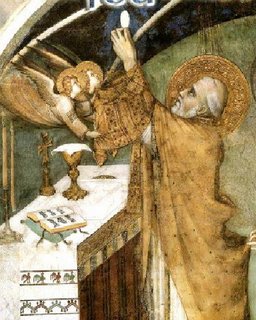
Earlier this year a
soccer player in Scotland was given a
cautionary warning by police for instigating strife during a soccer game. What was his offense? Did he flip the other team the bird? No, he made the Sign of the Cross to the opposing team, who happened to be non- Catholics! I suspect this was probably not done in a complete spirit of innocence given the previous crowd strife and riots that have occurred between these two rival soccer teams, the Rangers and the Celtics.
The Apostle Paul said the Cross of Christ was a stumbling block for many (1 Cor 1:23) and even just the
sign of the cross continues to be almost 2000 years later. If you get on the internet and peruse anti-catholic websites, they often bring up the
sign of the cross as an example of a "man-made" invention and a "tradition of Rome." This led me to look into the origin of the sign of the cross and why it engenders so much disdain among certain groups of our Protestant brethren.
Historically, the use of the sign of the cross can be traced to the second century and it's use in the early church has been documented by several of the early church Fathers.
"In all our travels and movements", says Tertullian (De cor. Mil., iii), "in all our coming in and going out, in putting of our shoes, at the bath, at the table, in lighting our candles, in lying down, in sitting down, whatever employment occupieth us, we mark our foreheads with the sign of the cross". On the other hand this must soon have passed into a gesture of benediction, as many quotations from the Fathers in the fourth century would show. Thus St. Cyril of Jerusalem in his "Catecheses" (xiii, 36) remarks: "let us then not be ashamed to confess the Crucified. Be the cross our seal, made with boldness by our fingers on our brow and in every thing; over the bread we eat and the cups we drink, in our comings and in goings; before our sleep, when we lie down and when we awake; when we are travelling, and when we are at rest".It appears that Catholic Christians have been using the sign of the cross for at least 1800 years and is now shared by Anglicans, some Lutherans and the Orthodox faith.
What does the sign of the cross do when we make it with our hand? Is it a magic incantation, or superstitious spell casting? No, quite the contrary. When a Christian makes the
sign of the cross, they are reminding themselves and others of the precious cross of Christ and His matchless sacrifice for them and the victory over sin and death. Before Catholics pray, we start our prayer by praying "in the name of the Father , the Son and the Holy Spirit" echoing the words of Christ in the gospel and simultaneously using our hands to trace the image of the Cross.
When I enter the Sanctuary at Mass, I dip my hands in the water reminding me of my baptismal vows and make the sign of the cross again reminding me of what Mass is all about and who and why I am there to worship. What a beautiful way to engage my heart towards Christ Jesus!
The Catholic faith is an incarnate faith. God came into the world in the flesh to redeem us and he continues to use the things of earth; water, incense,
sign of the cross etc. as a means of bringing us close to Him. (Incense calls to mind the "prayers of the saints" from the writings of John the Revelator as well as Old Testament worship practices, all of which are used to draw our physical senses to worship) Nothing spooky or evil about this. Just another example of how God uses the "stuff of earth" to bring our hearts towards heaven.
When I was a Protestant, we often would be asked to
bow our heads and close our eyes in prayer. This is not in the Bible but is a standard and well known way that Protestants draw their hearts to God. I venture to say that it is a "man-made invention" and not found in the Bible, but is a routine way for us to get ready to pray. In the same way, the sign of the cross is a physical gesture that is used to not only engage our hearts, but our bodies as well
reminding us of the one who died for us.
In a Catholic Mass, before the Gospel is read, the entire congregation rises to their feet and each of us traces the sign of the cross with our thumb on our forehead our lips and our hearts. As we trace the sign , we say to ourselves, "May the Word of God be in my mind and on my lips and in my heart. " What a precious prayer to ask the Holy Spirit to touch us with His Word!
This brought home another truth to me early in my conversion and that was how much Catholics honor the Word of God.
So in conclusion, yes the sign of the cross is a man-made invention that draws our hearts and minds and bodies to the greatest event in human history, God coming to earth and suffering on the cross for me. No wonder St. Cyril, from the early fifth century, suggested that this be the seal "over all our comings and goings" and every aspect of our lives. And by the way, you don't need to be Catholic to use the
sign of the cross, try it before you pray, or to start your day, it can bring you closer to Him! God bless you.
Labels: Devotional Practices, early church







